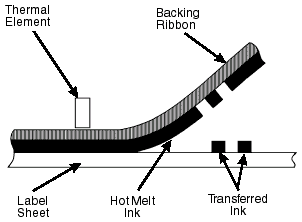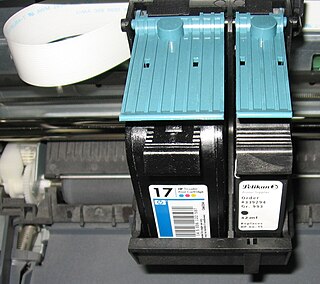
In the field of computing, a printer is considered a peripheral device that serves the purpose of creating a permanent representation of text or graphics, usually on paper. While the majority of outputs produced by printers are readable by humans, there are instances where barcode printers have found a utility beyond this traditional use. Different types of printers are available for use, including inkjet printers, thermal printers, laser printers, and 3D printers.

Laser printing is an electrostatic digital printing process. It produces high-quality text and graphics by repeatedly passing a laser beam back and forth over a negatively charged cylinder called a "drum" to define a differentially charged image. The drum then selectively collects electrically charged powdered ink (toner), and transfers the image to paper, which is then heated to permanently fuse the text, imagery, or both, to the paper. As with digital photocopiers, laser printers employ a xerographic printing process. Laser printing differs from traditional xerography as implemented in analog photocopiers in that in the latter, the image is formed by reflecting light off an existing document onto the exposed drum.

Inkjet printing is a type of computer printing that recreates a digital image by propelling droplets of ink onto paper and plastic substrates. Inkjet printers were the most commonly used type of printer in 2008, and range from small inexpensive consumer models to expensive professional machines. By 2019, laser printers outsold inkjet printers by nearly a 2:1 ratio, 9.6% vs 5.1% of all computer peripherals.

Dye-sublimation printing is a term that covers several distinct digital computer printing techniques that involve using heat to transfer dye onto a substrate.

Stationery refers to commercially manufactured writing materials, including cut paper, envelopes, writing implements, continuous form paper, and other office supplies. Stationery includes materials to be written on by hand or by equipment such as computer printers.

Thermal-transfer printing is a digital printing method in which material is applied to paper by melting a coating of ribbon so that it stays glued to the material on which the print is applied. It contrasts with direct thermal printing, where no ribbon is present in the process.

Toner is a powder mixture used in laser printers and photocopiers to form the text and images on paper, in general through a toner cartridge. Mostly granulated plastic, early mixtures added only carbon powder and iron oxide, however, mixtures have since been developed containing polypropylene, fumed silica, and various minerals for triboelectrification. Toner using plant-derived plastic also exists as an alternative to petroleum plastic. Toner particles are melted by the heat of the fuser, and are thus bonded to the paper.
Lexmark International, Inc. is a privately held American company that manufactures laser printers and imaging products. The company is headquartered in Lexington, Kentucky. Since 2016 it has been jointly owned by a consortium of three multinational companies: Apex Technology, PAG Asia Capital, and Legend Capital.
StyleWriter is a line of inkjet serial printers by Apple, targeted mainly towards consumers. They produced print quality that was better than the dot matrix ImageWriters, and were cheaper than the LaserWriters. All but a few models contained Canon print engines, while the last few were re-badged HP Deskjet printers. When Steve Jobs returned to Apple in 1997, he discontinued most of the company's accessory product lines, including the StyleWriter and LaserWriter.

An ink cartridge or inkjet cartridge is the component of an inkjet printer that contains the ink to be deposited onto paper during printing. It consists of one or more ink reservoirs and can include electronic contacts and a chip to exchange information with the printer.

Solid ink is a type of ink used in printing. Solid ink is a waxy, resin-based polymer that must be melted prior to usage, unlike conventional liquid inks. The technology is used most often in graphics and large-format printing environments where color vividness and cost efficiency are important.
ISO/IEC 19752Information technology — Method for the determination of toner cartridge yield for monochromatic electrophotographic printers and multi-function devices that contain printer components is an ISO/IEC standard method for the determination of toner cartridge yield for monochrome laser printers, introduced in June 2004 and updated in 2017.
Compatible ink is manufactured by third-party manufacturers and is designed to work in designated printers without infringing on patents of printer manufacturers. Compatible inks and toners may come in a variety of packaging including sealed plastic wraps or taped plastic wraps. Regardless of packaging, compatible products are generally priced lower than original equipment manufacturer (OEM) brand inks and toners.
Dynamic Cassette International (DCI) is an internationally recognised Boston, Lincolnshire, UK based ink cartridge and laser toner manufacturing company, producing products under the Jet Tec brand name. DCI is the sole UK manufacturer of compatible ink cartridges. DCI is notable for winning the Queen's Award for Enterprise: Innovation in 2004 and the Queen's Award for Export and being one of the biggest employers in Boston, employing over 300 staff at its 40,000 square metres factory. The company is currently Europe's largest manufacturer of compatible inkjet cartridges and has a turnover in excess of £20 million.

Toner refilling is the practice of refilling empty laser printer toner cartridges with new toner powder. This enables the cartridge to be reused, saving the cost of a complete new cartridge and the impact of the waste and disposal of the old one.
In 2009, the ISO/IEC published the International Standard for determining the ink cartridge yield for colour inkjet printers and multifunctional devices. This standard is used to prescribe the test method that manufacturers and test labs use to determine ink jet cartridge yields. It also standardizes the appropriate method of describing the yield of cartridges in documentation supplied to the consumer by the manufacturer. Manufacturers of printers or devices that use colour ink jet technology are meant to abide by this standard when testing for, and labeling the estimated yields of their products.
Island Ink-Jet is a large printer ink and laser toner supply chain store with stores in Canada and Puerto Rico. The brand is currently owned by The Equipment leasing company ltd. and based in Mississauga, Ontario, Canada, and locations operate under a franchising business model. The chain offer a printer ink cartridge refill service and sell several varieties of ink cartridges and toner cartridges including remanufactured cartridges.

The RemaxWorld Expo is an annual trade show comprising vendors from within the print consumables industry. The event began in 2007, resulting from a joint venture between the China Council for the Promotion of International Trade (CCPIT) and Recycling Times Media Corporation. Centered in Zhuhai, widely recognized as being the print consumables capital of the world, the exhibition currently takes place in the newly constructed Zhuhai International Convention & Exhibition Center. In 2015, the show accommodated 463 exhibitors and 13,938 visitors from 83 countries.
Katun is a supplier of OEM-compatible imaging consumables and supplies for office equipment.
Supertank printers are a type of continuous ink system (CISS) inkjet printer. Supertank printers differ from traditional inkjet printers in that the printhead is connected via a tube system that draws ink from large ink tanks built into the printer, which are filled and refilled via ink bottles, eliminating the need for ink cartridges. Cost-per-page (CPP) is significantly lower than traditional cartridges, as replacement ink bottles contain enough ink to print thousands of pages, and typically cost under $20.











